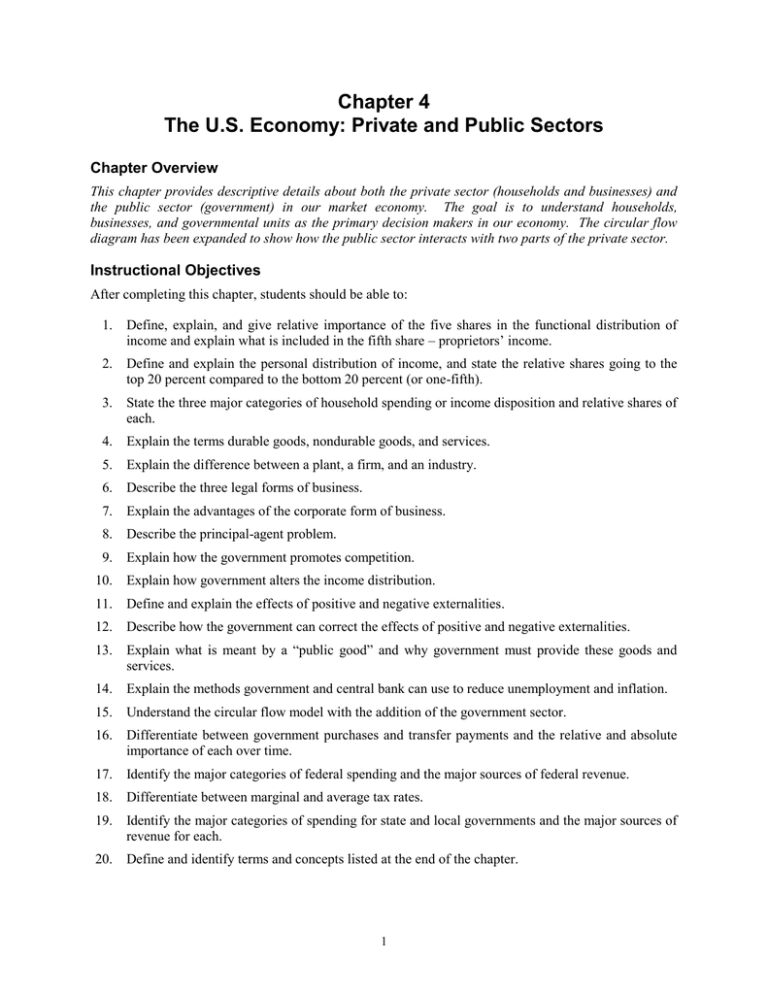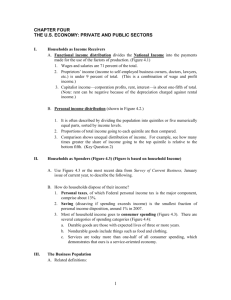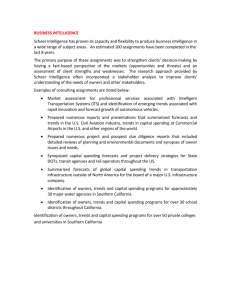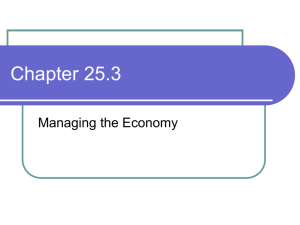Chapter 4 The U.S. Economy: Private and Public Sectors Chapter Overview
advertisement

Chapter 4 The U.S. Economy: Private and Public Sectors Chapter Overview This chapter provides descriptive details about both the private sector (households and businesses) and the public sector (government) in our market economy. The goal is to understand households, businesses, and governmental units as the primary decision makers in our economy. The circular flow diagram has been expanded to show how the public sector interacts with two parts of the private sector. Instructional Objectives After completing this chapter, students should be able to: 1. Define, explain, and give relative importance of the five shares in the functional distribution of income and explain what is included in the fifth share – proprietors’ income. 2. Define and explain the personal distribution of income, and state the relative shares going to the top 20 percent compared to the bottom 20 percent (or one-fifth). 3. State the three major categories of household spending or income disposition and relative shares of each. 4. Explain the terms durable goods, nondurable goods, and services. 5. Explain the difference between a plant, a firm, and an industry. 6. Describe the three legal forms of business. 7. Explain the advantages of the corporate form of business. 8. Describe the principal-agent problem. 9. Explain how the government promotes competition. 10. Explain how government alters the income distribution. 11. Define and explain the effects of positive and negative externalities. 12. Describe how the government can correct the effects of positive and negative externalities. 13. Explain what is meant by a “public good” and why government must provide these goods and services. 14. Explain the methods government and central bank can use to reduce unemployment and inflation. 15. Understand the circular flow model with the addition of the government sector. 16. Differentiate between government purchases and transfer payments and the relative and absolute importance of each over time. 17. Identify the major categories of federal spending and the major sources of federal revenue. 18. Differentiate between marginal and average tax rates. 19. Identify the major categories of spending for state and local governments and the major sources of revenue for each. 20. Define and identify terms and concepts listed at the end of the chapter. 1 Lecture Notes I. Learning objectives – In this chapter students will learn: A. Important facts about U.S. households and U.S. businesses. B. Why the corporate form of business organization dominates sales and profits. C. The problem that arises when corporate owners (principals) and their managers (agents) have different interests. D. About the economic role of government in the economy. E. The categories of government spending and the sources of government revenues. II. Households as Income Receivers A. Functional distribution of income is shown in Figure 4.1. 1. Wages and salaries are 71 percent of the total. 2. Proprietors’ income (income to self-employed business owners, doctors, lawyers, etc.) is under 10 percent of total. (This is a combination of wage and profit income.) 3. Capitalist income—corporation profits, rent, interest—is about one-fifth of total. (Note: rent can be negative because of the depreciation charged against rental income.) B. Personal distribution of income is shown in Figure 4.2. (This figure is based on PI— Personal Income.) 1. It is often described by dividing the population into quintiles or five numerically equal parts, sorted by income levels. 2. Proportions of total income going to each quintile are then compared. 3. Comparison shows unequal distribution of income. For example, see how many times greater the share of income going to the top quintile is relative to the bottom fifth. (Key Question 2) III. Households As Spenders (Figure 4.3) (Figure is based on household Income) A. Use Figure 4.3 or most recent data from Survey of Current Business, January issue of current year, to describe the following. B. How do households dispose of their income? 1. Personal taxes, of which Federal personal income tax is the major component, comprise about 12%. 2. Saving (dissaving if spending exceeds income) is the smallest fraction of personal income disposition, around 0% in 2005. (Negative $34 billion – caused in part by significant home equity borrowing to finance consumption) 3. Most of household income goes to consumer spending (Figure 4.3). There are several categories of spending categories (Figure 4.4): a. Durable goods are those with expected lives of three or more years. b. Nondurable goods include things such as food and clothing. c. Services are today more than one-half of all consumer spending, which demonstrates that ours is a service-oriented economy. 2 IV. The Business Population A. Related definitions: 1. Plant: physical establishment where production or distribution takes place (factory, farm, store). 2. Firm: business organization that owns and operates the plants. (The legal entity.) 3. Industry: a group of related firms, producing the same or similar products. a. Examples include the automobile industry or the tobacco industry. b. Confusion often occurs because many businesses are multiproduct firms. 4. Types of multiplant firms: a. Horizontal integrated: a multiplant firm with plants in the same stage, like a retail chain store such as J. C. Penney or Safeway. b. Vertical integrated: a multiplant firm in which the company owns plants at different production stages. Example: A steel company may own ore and coal mines as well as different plants in different stages of the manufacturing process. c. Conglomerate: a firm that owns plants in different industries or markets. B. Legal forms of businesses (Figure 4.5): 1. Definition: a. Sole proprietorship: a business owned by a single individual. b. Partnership: two or more individuals own and operate the business in a partnership agreement. c. Corporation: a legal entity distinct from its individual owners. The organization acts as “legal person.” 2. Discussion of Figure 4.5 relative to most important – percentage of firms versus percentage of sales. 3. Corporations have a number of advantages over non-corporate forms of business: a. Improved ability to raise financial capital by issuing stocks and bonds b. Limited liability – owners risk only what they pay for the stock. c. Corporations have a permanence that is conducive to long-run planning and growth. b. Disadvantages: red tape and expense in obtaining a corporate charter; unscrupulous business owners sometimes avoid responsibility for questionable business activities; double taxation of corporate income; possible inconsistency between owner objectives and manager objectives (principal-agent problem). 4. Principal-agent problem a. Corporations are often run by managers (agents) who are not owners (principals) of the company. b. The divergent interests of owners (principals) and managers (agents) lead to decisions not in the best interests of the owners. Owners want profits and share value maximized, managers want to maximize their own salaries, expense accounts, etc. 3 5. Consider This … Unprincipled Agents a. Executive stock options in 1990s to correct principal-agent problem led to fraud and abuse, as in the Enron and WorldCom cases. Deceptive (and in some cases illegal) accounting practices were used to inflate company stock prices so that executives could sell their shares and reap huge windfalls. b. In response, in 2002 Congress strengthened laws and penalties, and many corporations have taken action to improve accounting and auditing practices. V. The Public Sector: Government’s Role A. Providing the legal structure: 1. Government ensures property rights, provides enforcement of contracts, acts as a referee and imposes penalties for foul play. 2. Government intervention improves the allocation of resources by supplying a medium of exchange, ensuring product quality, defining ownership rights, and enforcing contracts. 3. These interventions widen the market and foster greater specialization in the use of property and human resources. 4. The appropriate amount of regulation is at the level where the marginal benefit and marginal cost are equal. B. Maintain competition: 1. Competition is the market mechanism that encourages producers and resource suppliers to respond to consumer sovereignty. 2. If producers (and/or resource suppliers) have monopoly power, the monopolist can charge higher-than-competitive prices and supplant consumer sovereignty with producer sovereignty (or economic rent). 3. If “natural monopoly” exists, government regulates price and service. (Natural monopoly exists when technology or economic realities make a monopoly more efficient than competition.) 3. Where competitive markets are more efficient, anti-monopoly laws (Sherman Act of 1890; Clayton Act of 1913) are designed to regulate business behavior and promote competition. Microsoft was found guilty of violating these laws in 2000. C. Redistribution of income: 1. Transfer payments provide relief to the poor, dependent, handicapped, and unemployment compensation to those unemployed who qualify for benefits. Social Security and Medicare programs support the sick and aged. 2. Government intervenes in markets by modifying prices. Price support programs for farmers; minimum wage laws are examples. 3. The personal income tax takes a larger proportion of incomes of the rich than the poor. D. Reallocation of resources: 1. Market failure occurs when the competitive market system produces the “wrong” amounts of certain goods or services or fails to provide any at all. 2. Externalities (spillovers) 4 a. Externalities occur when some of the benefits or costs of production are not fully reflected in market demand or supply schedules. Some of the benefits or costs of a good may “spill over” to third parties. b. An example of a negative externality (or external cost) is pollution, which allows polluters to enjoy lower production costs because the firm is passing along the cost of pollution damage or cleanup to society. Because the firm does not bear the entire cost, it will overallocate resources to the production of goods. c. Correcting for negative externalities requires that government get producers to internalize these costs. 1. Legislation can limit or prohibit pollution, which means the producer must bear costs of antipollution effort. 2. Specific taxes on the amounts of pollution can be assessed, which causes the firm to cut back on pollution as well as provide funds for government cleanup. d. Positive externalities occur when direct consumption by some individuals impacts third parties. Public health vaccinations and education are two examples. Because some of the benefits accrue to others, individuals will demand too little for themselves and resources will be underallocated by the market. e. Correcting for positive externalities requires that the government somehow increase demand to increase benefits to socially desirable amounts. 1. Government can increase demand by providing subsidies like food stamps and education grants to subsidize consumers. 2. Government can finance production of good or service such as public education or public health. 3. Government can increase supply by subsidizing production, such as higher education, immunization programs, or public hospitals. 3. Government provides public goods and quasi-public goods and services. a. Private goods are produced through the market because they are rival (one’s use of a good makes it unavailable for others) and come in units small enough to be afforded by individual buyers. Private goods are subject to excludability, the idea that those unable and unwilling to pay do not have access to the benefits of the product. b. Public or social goods would not be produced through the market, because they possess the characteristics of nonrivalry and nonexcludability. 1. The war on terrorism and national defense in general are good examples of public goods. Increased national security is there for all to enjoy whether or not they paid for it. Those who receive benefits without paying are part of the so-called free-rider problem. 2. Other examples include flood-control and public health. c. Producers would not be able to find enough paying buyers for “public goods” because of the free-rider problem mentioned above. Therefore, “public goods” are not produced voluntarily through the market but must be provided by the public sector and financed by compulsory taxes. d. Quasi-public goods are those that have large positive externalities, so government will sponsor their provision. Otherwise, they would be underproduced. Medical care, education, and public housing are examples. 5 e. Resources are reallocated from private to public use by levying taxes on households and businesses, thus reducing their purchasing power and using the proceeds to purchase public and quasi-public goods. This can bring about a significant change in the composition of the economy’s total output. 4. Consider This … Street Entertainers a. Street entertainers regularly appear in popular tourist areas in major cities. Even though some people pay when the “hat is passed,” many benefit from the shows without contributing to the cost (free-riding). b. Because local businesses benefit from the customers attracted by these performers, the businesses or local government will sometimes pay these entertainers. c. Even when government is not contributing to the cost of street entertainers, a public good is still being provided. E. Promoting stability: 1. An economy’s level of output is dependent on its level of total spending relative to its productive capacity. 2. The government may promote macroeconomic stability through changes in government spending and taxation. a. When total spending is too low, the government may increase its spending and/or lower taxes to reduce unemployment; the central bank may lower interest rates. b. When total spending is excessive, the government may cut its spending and/or raise taxes to foster price stability; the central bank may raise interest rates. F. Government’s Role: A Qualification 1. Government carries out its economic functions within a political context (and the constraints on activity that come with that). 2. In attempting to balance and satisfy both political and economic objectives, government may end up over- or under-regulation, or over- or under-providing public goods. VI. Circular Flow Revisited A. Figure 4.6 shows the circular flow model with the addition of the government sector. B. There are several modifications to the Chapter 2 model. 1. Flows (5) through (8) illustrate that government makes purchases and expenditures in both the product and resource markets. 2. Flows (9) and (10) illustrate that the government provides public goods and services to households and businesses. 3. Flows (11) and (12) illustrate that government receives taxes from and distributes subsidies to households and businesses. C. These flows suggest ways that the government might alter the distribution of income, reallocate resources, and change the level of economic activity. VII. Government Finance A. Government expenditures on goods and services and transfer payments. 1. Government purchases directly use or employ resources to produce goods or services measured in domestic output. 6 2. Government transfer payments are not directly part of domestic output, but include payments like social security, unemployment compensation, welfare payments, and subsidies to corporations. B. Government purchases of goods and services, expenditures on transfer payments, and total spending as percentages of U.S. output, 1960 and 2005 (Figure 4.7). C. Major growth in government spending since the 1960s has been in transfer payment area. VIII. Federal Finance (see Figure 4.8) A. Expenditures emphasize four important areas. 1. Income security (pensions and disability payments), 2. National defense, 3. Health, and 4. Interest on the public (national) debt. B. Receipts come from several sources. 1. Personal income tax is a major source. a. The Federal personal income tax is progressive. People with higher incomes pay a higher percentage of that income as tax than do people with lower incomes. b. A marginal tax rate is the rate at which the tax is paid on each additional unit of taxable income (Table 4.1). c. The average tax rate is the total tax paid divided by total taxable income. d. A tax whose average tax rises as income increases is progressive. 2. Payroll taxes, such as social security contributions, are a close second as source of revenue. 3. Corporate income taxes on corporation profits are the third largest source of revenue. 4. Excise taxes are similar to sales taxes on specific commodities, like alcoholic beverages, tobacco, and gasoline. They are levied at the wholesale level, so are hidden from the consumer. C. Global Perspective 4.2 shows that Australia, the United States, South Korea, and Japan enjoy relatively low tax burdens. European nations (particularly Scandinavian countries) have relatively high burdens. IX. State and Local Finance A. State expenditures and receipts differ in composition from the Federal government. 1. State revenues primarily come from sales and excise taxes (about 48 percent) and secondly from personal income taxes (about 34 percent). 2. States vary widely in terms of revenue sources, with seven having no personal income tax, and two having no general sales tax. 3. State spending goes primarily for public welfare, education, highways, and health care. B. Local revenues and spending differ from the state and federal levels. 1. Local revenue is derived primarily from property taxes. 2. Local spending is primarily on education. 7 3. Gap between local tax revenues and spending is largely filled by grants from state and Federal government (referred to as “intergovernmental grants”). X. LAST WORD: The Long-Run Fiscal Imbalance: Social Security A. There is an impending long-run shortfall in Social Security funding. 1. It is “pay-as-you-go” system, meaning that current revenues are used to pay current retirees (instead of paying from funds accumulated over time). 2. Despite efforts to build a trust fund, in 2017 Social Security revenues will fall below payouts to retirees. 3. In 2040 the trust fund will be exhausted and benefits will exceed revenues by an estimated 37 percent, with that figure rising to 56 percent annually in 2075. B. Demographic changes are creating the problem. 1. Baby boomers are entering retirement age and living longer, meaning that there will be more recipients receiving payouts for longer periods of time. 2. The ratio of the number of workers contributing to the system for each recipient has declined from 5:1 in 1960 to 3:1 today. By 2040 the ratio will be only 2:1. C. Numerous solutions have been suggested. 1. Reduce benefits by reducing direct payments, taxing benefits, and/or increasing the age at which workers are eligible to receive benefits (already part of the system) 2. Increase revenues by raising payroll taxes. 3. Increase the trust fund by setting aside more of current system revenues, or by investing trust fund monies in corporate stocks and bonds. 4. Allow workers to invest half of their payroll taxes in approved stock and bond funds – sometimes referred to as “privatizing” Social Security. D. There are many possible solutions, and the political process may well result in a combination of the many policies proposed. 8






